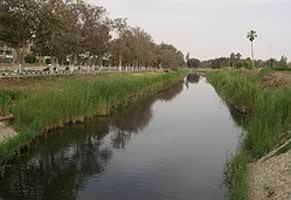Status Open End point Port Said Construction began 1861 | Date completed 1863 Start point Lake Timsah | |
 | ||
Sweet Water Canal, also known as Fresh Water Canal and currently known as Ismaïlia Canal, is a canal which was dug by thousands of Egyptian fellahin to facilitate the construction of the Suez Canal. The canal travels east-west across Ismailia Governorate.
Contents
It was dug to provide fresh water to the arid area, from Lake Timsah to Suez and Port Said. The canal facilitated the growth of agriculture settlements along the Suez Canal, and it is particularly important for supplying water to the city of Port Said. Like the Suez Canal, it was designed by French engineers; construction lasted from 1861 until 1863. It runs through the now-dry distributary of the Wadi Tumilat, incorporating portions of an ancient Suez Canal that existed between Old Cairo and the Red Sea.
Construction
In February 1862, after thousands of workers excavated 1.1 million cubic meters, the canal reached Lake Timsah. As soon as the fresh water reached the area, more laborers could be (and were) hired for the Suez Canal construction project. The canal also allowed for the easy transportation of materials and food with ferries traveling along its narrow ways.
Battle of Kassassin Lock
The Battle of Kassassin Lock was fought near Sweet Water Canal, on August 28, 1882.
Anglo-Egyptian War
Less than 100 years later, the canal no longer provided clean, fresh water but was disturbingly polluted. During the 1950s when British soldiers were stationed in the area, some referred to the canal as an open sewer. Royal Air Force personnel were advised to avoid contact with the water and were warned that the canal was where deserters would end up. When the war became especially bloody, between national, Egyptian, resistance movements and British soldiers, from October 1951 to January 1952, the remains of some of the British soldiers who were tortured and killed, ended up in the canal.
